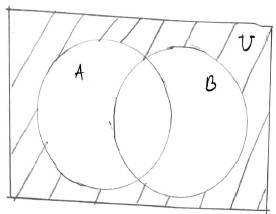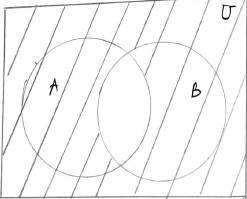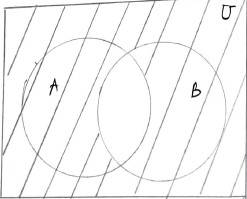Maths
Get insights from 6.5k questions on Maths, answered by students, alumni, and experts. You may also ask and answer any question you like about Maths
Follow Ask QuestionQuestions
Discussions
Active Users
Followers
New answer posted
6 months agoContributor-Level 10
44. Given, n (S) = 21
n (T) = 32
n (S T) = 11.
Using, n (S T) = n (S) + n (T) n (S T)
= 21 + 32 11
= 42.
New answer posted
6 months agoContributor-Level 10
43. Let H and E be set if people who speak Hindi and English respectively. there,
n (H) = 250, people speak Hindi n (E) = 200, people speak English
n (H E) = 400, people speaks either Hindi or English
So, n (H E) = n (H) + n (E) n (H E)
= 250 + 200 400
= 50
So, 50 people can speak both Hindi and English.
New answer posted
6 months agoContributor-Level 10
42. Given, n (X Y) = 18.
n (X) = 8.n (Y) = 15.n (X Y) =?
Using n (X Y) = n (X) + n (Y) n (X Y)
= 8 + 15 18.
= 5.
New answer posted
6 months agoContributor-Level 10
41. Given, n (X)= 17
n (Y) = 23
n (X Y)= 38.
So, n (X Y) = n (X) + n (Y) n (X Y)
n (X Y) = n (X) + n (Y) n (X Y)
= 17 + 23 38.
= 2
New answer posted
6 months agoContributor-Level 10
40. (i) A A = U
(ii) ∩ A = U ∩ A = A.
(iii) A ∩ A = .
(iv) U ∩ A = ∩ A = .
New answer posted
6 months agoContributor-Level 10
39. A = U – A
= Set of all triangle in a plane - Set of all triangle with at least the angle different from 60°.
= Set of all triangle with each angle 60°.
A? = set of all equilateral triangle.
New answer posted
6 months agoContributor-Level 10
38. (i) (A B) = U – (A B)

(ii) A ∩ B = (AU B) = U – (AU B)



New answer posted
6 months agoContributor-Level 10
37. (i) L.H.S = (A B) = U – (A B)
= {1,2,3,4,5,6,7,8,9} – [ {2,4,6,8) {2,3,5,7}]
= {1,2,3,4,5,6,7,8,9} – {2,3,4,5,6,7,8}
= {1,9}
R.H.S. = A ∩ B = [U – A] ∩ [U B]
= ∩
= {1,3,5,7,9} ∩ {1,4,6,8,9}
= {1,9}
? L.H.S. = R.H.S.
(A B) = A ∩ B.
(ii) L.H.S. = (A ∩ B) = U – (A ∩ B)
= {1,2,3,4,5,6,7,8,9} – [ {2,4,6,8} ∩ {2,3,5,7}]
= {1,2,3,4,5,6,7,8,9} – {2}
= {1,3,4,5,6,7,8,9}
R.H.S. = A B
= [U – A] [U – B]
= [ {1,2,3,4,5,6,7,8,9} – {2,4,6,8}] [ {1,2,3,4,5,6,7,8,9} – {2,3,5,7}]
= {1,3,5,7,9} {1,4,6,8,9}
= {1,3,4,5,6,7,8,9}
? L.H.S. = R.H.S.
(A ∩ B) = A B.
New answer posted
6 months agoContributor-Level 10
3. (i) {x : x is an odd natural number}
(ii) {x : x is an even natural number}
(iii) {x : x is not a multiple of 3}
(iv) {x : x is a positive composite number and x = 1}
(v) {x : x is a natural number not divisible by 3 and 5}.
(vi) {x : x is not a perfect square}
(vii) {x : x is not a perfect cube}
(viii) We have, x + 5 = 8.
x = 8 – 5 = 3
x = 3
? {x : x ≠ 3, x? N}
(ix )We have,
2x + 5 = 9
2x = 9 – 5
2x = 4
x = 2
? {x : x? N and x ≠ 2}
(x) {x : x < 7} = {1,2,3,4,5,6}
(xi) We have,
2x + 1 >10
2x >10 – 1
x >
? = {1,2,3,4}
New answer posted
6 months agoContributor-Level 10
35. (i) A = U – A = {a, b, c, d, e, f, g, h} – {a, b, c}
= {d, e, f, g, h}
(ii) B = U – B = {a, b, c, d, e, f, g, h} – {d, e, f, g}
= {a, b, c, h}.
(iii) C = U – C = {a, b, c, d, e, f, g, h} – {a, c, e, g}.
= {b, d, f, h}
(iv) D = U – D = {a, b, c, d, e, f, g, h} – {f, g, h, a}
= {b, c, d, e}
Taking an Exam? Selecting a College?
Get authentic answers from experts, students and alumni that you won't find anywhere else
Sign Up on ShikshaOn Shiksha, get access to
- 65k Colleges
- 1.2k Exams
- 679k Reviews
- 1800k Answers
